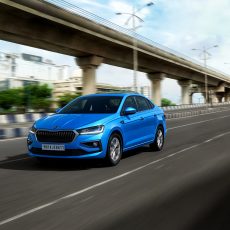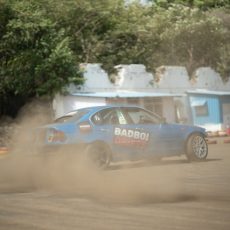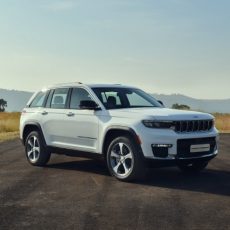 With winter about to set in, there came this opportunity for me to go river rafting in the ice-cold waters of the River Ganga at Rishikesh. Luck favoured me, for Honda Siel stepped in at the right moment and lent me their luxurious white Jazz Select for this trip
With winter about to set in, there came this opportunity for me to go river rafting in the ice-cold waters of the River Ganga at Rishikesh. Luck favoured me, for Honda Siel stepped in at the right moment and lent me their luxurious white Jazz Select for this trip
Words: Amit Pandey
Photography: Sanjay Raikar
It was on a Friday that I planned to leave for Rishikesh. My colleague, ace photographer Sanjay Raikar, flew down to New Delhi from our editorial headquarters in Pune to join me. We started from New Delhi about 2.30 pm. By way of preliminary preparations, I had drawn up a route map. I knew that, unlike the Jazz X, the Select would not be equipped with a USB port, so I decided to dedicate the journey to Delhi’s FM channels for a change.
We were to travel on NH 58 and the distance was an easily manageable 265 km. Driving through dense highway traffic via the industrial city within the NCR and then Ghaziabad, we entered Uttar Pradesh. Despite our slow movement we were able to manage a fuel economy of 15.1 km per litre even before hitting the highway. Soon we were on a newly laid road connecting to NH 58, which offered us some respite from heavy traffic. Now was the time to press the accelerator. The Jazz was cruising at about 90 km/h when I espied a vehicle that had popped up from nowhere, as it were, just a few metres away. Not to worry, though. The car’s efficient brakes easily brought the speed down to 30 km/h and we let the other vehicle cross the road.
 Soon we were on a single-lane road and in the midst of a massive traffic jam. There were lorries with long trailers, buses full of passengers with a few sitting atop their roofs and slow-moving tractors laden with bales of hay, not to speak of herds of buffaloes. This was NH 58 for us. The distance yet to be covered was about 240 km. Surprised by the state of an important national highway, we moved on towards Modinagar. The advantage of having the Jazz at one’s disposal is that it does not compromise on passenger comfort. The a-c vents were bountiful with their soothing cool air. While being stuck in the traffic jam, the noise outside made me wonder whether the engine of my Select was running. I had to rev it up a little to make sure! That’s another praiseworthy attribute of the Jazz. Its engine is almost inaudible not only when the car is stationary, but even at low speeds.
Soon we were on a single-lane road and in the midst of a massive traffic jam. There were lorries with long trailers, buses full of passengers with a few sitting atop their roofs and slow-moving tractors laden with bales of hay, not to speak of herds of buffaloes. This was NH 58 for us. The distance yet to be covered was about 240 km. Surprised by the state of an important national highway, we moved on towards Modinagar. The advantage of having the Jazz at one’s disposal is that it does not compromise on passenger comfort. The a-c vents were bountiful with their soothing cool air. While being stuck in the traffic jam, the noise outside made me wonder whether the engine of my Select was running. I had to rev it up a little to make sure! That’s another praiseworthy attribute of the Jazz. Its engine is almost inaudible not only when the car is stationary, but even at low speeds. 
 Our speed averaged 35 km/h as we passed through Modinagar and it took us another 45 minutes to reach Meerut. The road suddenly widened into two lanes with a broad divider as we took the city bypass. Sanjay and I decided to take a tea break at a wayside dhaba. We were now 72 km away from our starting point in New Delhi and it had taken us more than two-and-a-half hours to make it to the Meerut bypass. As expected, the Jazz returned 15.20 kpl until this point.
Our speed averaged 35 km/h as we passed through Modinagar and it took us another 45 minutes to reach Meerut. The road suddenly widened into two lanes with a broad divider as we took the city bypass. Sanjay and I decided to take a tea break at a wayside dhaba. We were now 72 km away from our starting point in New Delhi and it had taken us more than two-and-a-half hours to make it to the Meerut bypass. As expected, the Jazz returned 15.20 kpl until this point.
The prospect of a wide road ahead delighted us. I stepped on the pedal and the Jazz began gobbling up the kilometres in right earnest. I would like to touch upon a point here, one which all of us have experienced some time or other. The national highways and city bypasses should not have human settlements nearby. However, our highways and bypasses are hemmed in not only by residential settlements and colonies, but also a few well-established educational institutions. The whole set-up is highly prone to mishaps and casualties. The absence of pedestrian bridges or subways further compounds the problem. Innumerable were the times I had to apply the brakes as students tumbled out of college or university gates right along the bypass.

 As we passed through Darula, the road became even better. It was now lined by green pastures and farmlands. We were about 100 km away from New Delhi now and the FM channels entertained us with a variety of music. The car easily managed to touch a speed of 140 km/h on a straight stretch and our average speed now was about 110 km/h. The Honda Jazz is truly the fastest among the 1.2-litre petrol brigade. Soon we reached Muzaffarnagar as the light began to fade. After a nice speedy stretch of 45 km, the road narrowed down to a single lane with heavy oncoming traffic. The signboard read Roorkee 48 km and Haridwar 79 km. Now the road was cluttered by a number of bullock-carts laden with sugar-cane. It was 7.50 pm when we reached Haridwar. Crossing the great pilgrimage city, we continued towards Rishikesh about 35 km away, where we arrived at 8.40 pm. The temperature was pleasantly lower than that in New Delhi. Sanjay and I checked in at Hotel Nataraj where cosy rooms and a delicious dinner awaited us. I went to sleep dreaming about the rafting to be done on Saturday morning.
As we passed through Darula, the road became even better. It was now lined by green pastures and farmlands. We were about 100 km away from New Delhi now and the FM channels entertained us with a variety of music. The car easily managed to touch a speed of 140 km/h on a straight stretch and our average speed now was about 110 km/h. The Honda Jazz is truly the fastest among the 1.2-litre petrol brigade. Soon we reached Muzaffarnagar as the light began to fade. After a nice speedy stretch of 45 km, the road narrowed down to a single lane with heavy oncoming traffic. The signboard read Roorkee 48 km and Haridwar 79 km. Now the road was cluttered by a number of bullock-carts laden with sugar-cane. It was 7.50 pm when we reached Haridwar. Crossing the great pilgrimage city, we continued towards Rishikesh about 35 km away, where we arrived at 8.40 pm. The temperature was pleasantly lower than that in New Delhi. Sanjay and I checked in at Hotel Nataraj where cosy rooms and a delicious dinner awaited us. I went to sleep dreaming about the rafting to be done on Saturday morning. 
 The morning found us headed for Shivpuri, a small village up in the hills, famous for being the starting point for rafting trips on the River Ganga. Shivpuri is about 26 km away from Rishikesh. Going downstream, a one-way trip takes about three hours and it ends at the famous Ram Jhoola. River rafting trips are primarily organised by local tourist operators who own the boats and also have expert guides. Rishikesh is a geographically important location where the River Ganga flows from the Shivalik range of mountains towards the Indo-Gangetic plains of northern India.
The morning found us headed for Shivpuri, a small village up in the hills, famous for being the starting point for rafting trips on the River Ganga. Shivpuri is about 26 km away from Rishikesh. Going downstream, a one-way trip takes about three hours and it ends at the famous Ram Jhoola. River rafting trips are primarily organised by local tourist operators who own the boats and also have expert guides. Rishikesh is a geographically important location where the River Ganga flows from the Shivalik range of mountains towards the Indo-Gangetic plains of northern India.
 We had a booking with a local operator named River Zone. Their vehicle, required to carry rafting equipment to the starting point, was delayed. Having the Jazz at our disposal, we offered to carry the jackets, caps, paddles and bags to the riverside for the entire group. We could do so easily thanks to the car’s copious interior space. We drove the car up to the actual starting point to download all the equipment. Now it was time to take the plunge. I wore the life-jacket and walked towards the bank. There were seven others sailing in the same boat. It was 12.00 noon. The plan was that I would raft down with the group and reach Rishikesh while Sanjay drove the Jazz back.
We had a booking with a local operator named River Zone. Their vehicle, required to carry rafting equipment to the starting point, was delayed. Having the Jazz at our disposal, we offered to carry the jackets, caps, paddles and bags to the riverside for the entire group. We could do so easily thanks to the car’s copious interior space. We drove the car up to the actual starting point to download all the equipment. Now it was time to take the plunge. I wore the life-jacket and walked towards the bank. There were seven others sailing in the same boat. It was 12.00 noon. The plan was that I would raft down with the group and reach Rishikesh while Sanjay drove the Jazz back.

 This rafting trip downstream to Rishikesh until Muni Ki Reti, the point where it ends, was simply awesome! I got wet, felt butterflies in my stomach and was awed by the grand vista spread by Mother Nature all around. The boat sailed below the famous Laxman Jhoola followed by the Ram Jhoola. The river rafting adventure came to an end about 3.30 pm near the Ram Jhoola. As planned, Sanjay was waiting for me at the point. We drove back to the hotel.
This rafting trip downstream to Rishikesh until Muni Ki Reti, the point where it ends, was simply awesome! I got wet, felt butterflies in my stomach and was awed by the grand vista spread by Mother Nature all around. The boat sailed below the famous Laxman Jhoola followed by the Ram Jhoola. The river rafting adventure came to an end about 3.30 pm near the Ram Jhoola. As planned, Sanjay was waiting for me at the point. We drove back to the hotel.
About 5.00 pm we decided to go sightseeing. Famous for a variety of stones, yogic meditation and riverside rituals, Rishikesh bustles with tourists from all over the world. Since the Jazz was not allowed inside, we walked around to experience the place. A walk across the Laxman Jhoola and Ram Jhoola was exciting. We also walked around the ghats, markets, temples, ashrams, yoga and meditation centres and monasteries. It was 9.00 pm when we headed back for our dinner. Rishikesh is a vegetarian and alcohol-free city by law.
 We had to leave for New Delhi the next day. We started by 10.00 am. On our way back, we were diverted via a longer route at Haridwar. A policeman informed us that the day being an auspicious day, a massive assembly of people was expected for a holy dip in the Ganga. The diversion luckily led us to the scenic ‘Chilla’ towards Haridwar. We passed through the Rajaji National Park en route. We also saw several dams built on various tributaries of the Ganga.
We had to leave for New Delhi the next day. We started by 10.00 am. On our way back, we were diverted via a longer route at Haridwar. A policeman informed us that the day being an auspicious day, a massive assembly of people was expected for a holy dip in the Ganga. The diversion luckily led us to the scenic ‘Chilla’ towards Haridwar. We passed through the Rajaji National Park en route. We also saw several dams built on various tributaries of the Ganga.
Needless to add, the Jazz never once deviated from her customary sang-froid throughout our drive back to New Delhi. We had the dual satisfaction of having been to a scenic place in a highly comfortable conveyance. What more can one ask for?

 CAPTIONS:
CAPTIONS:
1. Shivpuri, the hub of river rafting adventure. It all starts here
2. In the end, I sat wondering what happened. With River Zone guide, Manoj
3.Zooming past the world’s largest comprehensive Hindu temple, the Swaminarayan Akshardham, in Delhi
1. A substitute for rock-climbing, isn’t it? Local camp organisers exploit every bit of the resources available to them in order to woo tourists
2. The colourful market of Rishikesh is a great attraction for tourists
3. Jazzing up to the starting point at Shivpuri, on the bank of the River Ganga
6. On the way to Shivpuri. The Honda Jazz is a driver’s pleasure
5. Several groups with their respective boats at the starting point at Shivpuri, all set for the white water rafting downstream to Rishikesh
4.Many local river rafting organisers have their own starting points. The raw beauty is worth the adventure
1. A local eatery. Ask for the menu and the waiter points to this
2. The boat could accommodate all the rafting equipment of eight people
3.Our white water rafting organiser, River Zone. One can find several such local organisers around Rishikesh and Shivpuri
Honda designers have thought of every inch in the Jazz to offer such a commodious boot. Flexible rear seats further contribute to one’s convenience
1. A bridge over the Ganga a little ahead of Shivpuri. Jumping from such bridges into the river is strictly prohibited
2. The dried up bed of a local tributary. We encountered several such locations on our way to Haridwar via Chilla
3. The diversion to Chilla proved lucky for us
Rishikesh: A Few Facts at a Glance
>> The River Ganga flows from the Shivalik range of mountains towards the Indo-Gangetic plains of north India
>> Famous for ancient temples, religious rituals on the ghats, valuable stones, meditation centres, monasteries and market
>> Known as the world capital of yogic meditation
>> A strictly vegetarian and alcohol-free city by law
>> Must do’s include white water rafting, kayaking, jungle or riverside camping and trekking
>> Must visits include aaratis on the ghats, temples, the Ram Jhoola and Laxman Jhoola
>> On-the-spot bookings recommended for river rafting. Negotiable, one trip costs Rs 700 per head
>> Rafting equipment is provided by the organisers
>> If time allows, other places worth visiting are Dehradun, Mussoorie, Rajaji National Park, Haridwar, Jim Corbett National Park and Tehri Dam reservoir etc
BLURB
That’s another praiseworthy attribute of the Jazz. Its engine is almost inaudible not only when the car is stationary, but even at low speeds




